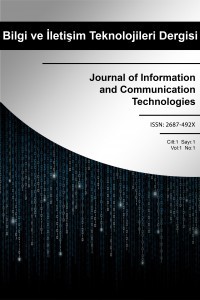Prezi Kullanımının Akademik Başarıya ve Bilgi Kalıcılığına Etkisi
Bu araştırmanın amacı, bulut tabanlı Prezi sunu aracı vasıtasıyla anlatılan derslerin öğrencilerin akademik başarısına ve öğrenme kalıcılığına etkisini ortaya çıkarmaktır. Nicel bir araştırma olan bu çalışmada deneysel desenlerden son test kontrol gruplu model kullanılmıştır. Bu araştırmanın çalışma grubunu 2018-2019 akademik yılı bahar döneminde Bartın Üniversitesi Eğitim Fakültesi Türkçe bölümü 1. Sınıfta eğitim ve öğrenimine devam eden 47 öğretmen adayı oluşturmaktadır. Öğrenciler seçiksiz atama yapılarak Prezi sunu aracı kullanılarak ders sunumlarının gerçekleştiği deney grubuna ve geleneksel olarak PowerPoint sunu aracı kullanılarak ders sunumlarının gerçekleştiği kontrol grubuna dağıtılmıştır. Konu anlatımlarının bitiminin akabinde öğrencilerin akademik başarısını belirlemek için her iki gruba da akademik başarı testi uygulanmıştır. Derslerin bitiminden 10 hafta sonra, yapılan sunumların uzun vadedeki etkisini değerlendirebilmek için aynı başarı testi her iki gruptaki öğrencilere tekrar uygulanmıştır. Araştırmadan elde edilen veriler üzerinde yapılan analizler neticesinde, Prezi sunumları kullanılarak anlatılan dersler ile geleneksel olarak PowerPoint sunumu kullanılarak anlatılan derslerin öğrenci başarısına etkisinde anlamlı bir farklılığın olmadığı bulunmuştur. Fakat, Prezi ile sunulan derslere katılan öğrenciler, PowerPoint ile sunulan derslere katılan öğrencilere göre öğrendikleri bilgileri uzun vadede hatırlama düzeyleri anlamlı bir biçimde daha yüksek çıkmıştır.
Anahtar Kelimeler:
Prezi, PowerPoint, Sunum aracı, Akademik başarı, Bilgi kalıcılığı
Effects of Utilizing Prezi on Academic Achievement and Knowledge Retention
The aim of this research was to reveal the effects of the lessons taught by using the cloud-based Prezi presentation tool on students' academic achievement and learning retention. In this quantitative study, the posttest-only control group design from experimental research designs was used. The sample group of this study consisted of 47 pre-service teachers who were freshmen and were studying in the department of Turkish Language Education, Faculty of Education at Bartın University. The students were randomly assigned to the experimental group in which the lecture took place using the Prezi presentation tool and to the control group in which the lecture took place using the traditional PowerPoint presentation tool. The academic achievement test was applied to both groups to determine the students’ academic achievement after the completion of the lectures. 10 weeks after administering the first test, the same academic achievement test was applied to the students in both groups to evaluate the long-term impact of the presentations. As a result of analyzing data obtained from the research, it was found that there was no significant difference in the effects of the lessons taught using Prezi presentations and the lessons traditionally taught using PowerPoint presentations on student achievement. However, the students who attended the courses taught using Prezi were significantly higher in the long-term recall of the information they learned than the students who attended the courses taught using PowerPoint.
Keywords:
Prezi, PowerPoint, Presentation tool, Academic Achievement, Knowledge retention,
___
- Anderson, L. W., Krathwohl, D. R., & Bloom, B. S. (2002). A taxonomy for learning, teaching, and assessing: A revision of Bloom's taxonomy of educational objectives. Theory into Practice, 41(4), 211-218.
- Chou, P. N., Chang, C. C., & Lu, P. F. (2015). Prezi versus PowerPoint: The effects of varied digital presentation tools on students’ learning performance. Computers & Education, 91, 73-82.
- Craig, R. J., & Amernic, J. H. (2006). PowerPoint presentation technology and the dynamics of teaching. Innovative Higher Education, 31(3), 147-160.
- Çakmak, E. K. (2007). Çoklu ortamlarda dar boğaz: Aşırı bilişsel yüklenme. Gazi Üniversitesi Gazi Eğitim Fakültesi Dergisi, 27(2), 1-24.
- Diamond, S. (2010). Prezi for dummies. John Wiley & Sons.
- Duffy, R. M., Guerandel, A., Casey, P., Malone, K., & Kelly, B. D. (2015). Experiences of using Prezi in psychiatry teaching. Academic Psychiatry, 39(6), 615-619.
- Hair, J. F., Black, W. C., Babin, B. J., Anderson, R. E., & Tatham, R. L. (2013). Multivariate Data Analysis: Pearson Education Limited.
- Huang, Y. M. (2017). Exploring the intention to use cloud services in collaboration contexts among Taiwan’ private vocational students. Information Development, 33(1), 29-42.
- Karasar, N. (2009). Bilimsel araştırma yöntemi: kavramlar-ilkeler-teknikler. Nobel Yayın Dağıtım.
- Kinchin, I. M., Hay, D. B., & Adams, A. (2000). How a qualitative approach to concept map analysis can be used to aid learning by illustrating patterns of conceptual development. Educational research, 42(1), 43-57.
- Mayer, R. E. (2001). Multimedia learning. New York: Cambridge University Press.
- Monetle, D.R., Sullivan, T.J., & DeJong C.R. (1990). Applied Social Research. New York: Harcourt Broce Jovanovich, Inc.
- Özen, Y., & Gül, A. (2007). Sosyal ve eğitim bilimleri araştırmalarında evren-örneklem sorunu. Atatürk Üniversitesi Kazım Karabekir Eğitim Fakültesi Dergisi, (15), 394-422.
- Perron, B., & Stearns, A. (2010). A review of a presentation technology: Prezi. Research on Social Work Practice, 1-2.
- Rahimi, E., van den Berg J. & Veen, W. (2015) Facilitating student-driven constructing of learning environments using Web 2.0 personal learning environments. Computers and Education, 81, 235–246.
- Rahman, H. A., Asrowi, A., & Ahyar, M. (2018). Development of Learning Media Based on Prezi on Sociology Subject at 11th Grade of Social Program. International Journal of Multicultural and Multireligious Understanding, 5(4), 442-452.
- Settle, Q., Abrams, K. M., & Baker, L. M. (2011). Using Prezi in the classroom. NACTA Journal, 55(4), 105-106. Špernjak, A. (2014). Is Prezi more usefullness education tool than PowerPoint?. The Eurasia Proceedings of Educational and Social Sciences, 1, 191-195.
- Strasser, N. (2014). Using Prezi in higher education. Journal of College Teaching & Learning, 11(2), 95.
- Sweller, J. (1988). Cognitive load during problem solving: Effects on learning. Cognitive Science, 12, 257-285.
- Sweller, J., Van Merrienboer, J. J. G. ve Paas, F. G. W. C. (1998). Cognitive architecture and instructional design. Educational Psyhology Review, 10(3), 251-296.
- Thomas, P. Y., (2011). Cloud computing: A potential paradigm for practising the scholarship of teaching and learning. The Electronic Library, 29(2), 214-224.
- Ustun, A. B. (2019). Students’ experiences in learning and using Prezi in higher education. Bartın Üniversitesi Eğitim Fakültesi Dergisi, 8(3), 928-946.
- ISSN: 2687-492X
- Yayın Aralığı: Yılda 2 Sayı
- Başlangıç: 2019
- Yayıncı: Ramazan Yılmaz
